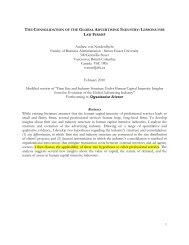Date: April 12, 2013 Topic: The Shrinking ... - Georgetown Law
Date: April 12, 2013 Topic: The Shrinking ... - Georgetown Law
Date: April 12, 2013 Topic: The Shrinking ... - Georgetown Law
Create successful ePaper yourself
Turn your PDF publications into a flip-book with our unique Google optimized e-Paper software.
General Counsel with Power? 2011 <br />
<strong>The</strong> second cluster (see red legends in Figure 6) concerns Internalizers. <strong>The</strong>y rely heavily on internal <br />
legal resources, are most systematic in implementing the production-‐line approach, and view <br />
themselves as legal strategists in charge of managing legal projects and process flows. <br />
This study attempted to provide a systematic analysis of current trends and possible future directions in <br />
legal services. We conclude by summarizing a set of key factors that will influence who drives power in <br />
legal service global value chains in the future. <br />
It is often argued that corporate clients are becoming a force for change in legal services. However, the <br />
general counsel’s power to drive change in a sustainable manner depends on the sources of power. <strong>The</strong> <br />
most temporary of GC power lies in the buyer’s market during the post-‐financial crisis recession. Much <br />
of the bargaining power resulting from the economic climate is likely to erode when the economy picks <br />
up. By contrast, the general counsel will remain a more sustainable force for change if they proactively <br />
invest in new capabilities such as project management, as Internalizer GCs are doing. So, law firms, <br />
beware of Internalizers amongst the general counsel. However, GCs with a power base in corporate <br />
managerial hierarchy may not necessarily regard efficient legal service delivery on a strategic par with <br />
legal risk management. If such GCs dominate the in-‐house legal function, power does not equate to an <br />
appetite for change. It is, therefore, equally possible that we are heading for a supply side revolution <br />
with new entrants – legal services providers – driving discrete and disruptive changes in the way legal <br />
services are delivered. <br />
25 <br />
Said Business School | University of Oxford
















